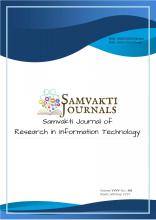+91-9958 726825
An Analysis of Wireless Network Virtualisation
|
The overall expenses of constructing and managing a wireless network might be significantly reduced thanks to wireless network virtualization, which enables for the generalization and exchange of radio spectrum design and assets. By isolating a segment of the system, wireless network virtualization could simplify things to migrate to updated goods or techniques. Regardless of the potency of wireless network virtualization, innumerable major research hurdles must also be acknowledged before widespread deployment, including exclusion, tracking alerting, asset immersion and allotment, packet transmission, network management and implementation, and confidentiality, as well as non-technical troubles such as governance regulations. In this article, we provide a brief summary of a few of the prior attempts to achieve wireless network virtualization, as well as discuss pertinent research issues and roadblocks. Wireless network virtualization requires an overview, motivations, organization, performance measurements, enabling technologies, and challenges. Finally, author address the ramifications of wireless network virtualization on a larger scale.
|
|
Virtualization has become a prominent idea in information and communications technology (ICT) industry in a variety of domains, including virtual data, virtual computers, virtual storage access networks, and data centres which are virtual. It entails resource generalisation and distribution among many users. Because of higher utilization of hardware, de coupled functions from arrangement, faster relocation to novel services and items, and malleable administration, the total charge of equipment and managing may be substantially lowered with virtualization. It has been happening in wired networks for many years, such as virtual private networks (VPNs) over wide area networks (WANs) and virtual local area networks (VLANs) in corporate network. Network virtualization has recently been utilized extensively in Internet research test beds such as G-Lab and 4WARD, as well as in the cloud computing environment. Its goal is to break through the existing Internet's resistance to major architectural modifications. Network virtualization is being regarded to be one of major capable Internet technology.
It's only logical to expand virtualization to wireless networks, given the enormous increase in wireless traffic and services. System structure may be separated from the facilities it delivers using wireless network virtualization, allowing varied service to operate on the same infrastructure while optimizing its usage. As a result, numerous virtual networks which are wireless run on various SPs may distribute external substrate wireless network functioned through mobile network machinists in a dynamic manner (MNOs). The capital and operating costs (CapEx) of wireless (radio) acccess network (RANs) and core network (CNs) may substantially lowered thanks to wireless network virtualization, which allows structure and radio spectrum resources to be shared. Furthermore, mobile virtual network operators (MVNOs) that deliver specialized service related to telecom (example, over-the-top service, VoIP and video calls) may assist MNOs in attracting additional customers, whereas MNOs could generate additional income through hiring secluded network which is virtualized to these and testing novel service. In the meantime, by separating part of network, WNV makes it naiver to relocate to novel goods or technology whereas still maintaining older items. Furthermore, the emergence of diverse wireless networks necessitates a dominant and convergent appliance for network management, which wireless network virtualization may offer. Regardless of the potential of wireless network virtualization, numerous major research hurdles, including reclusion, monitoring signaling, raw material discovery and distribution, movement management, network maintenance and control, and privacy, along with non-technical issues like literature on corporate governance, must be acknowledged before massive implementation. In comparison to wired broadband, where spectrum resource alteration and separation could be done in hardware (example, port & link) basis, radio resource generalization and segregation are difficult because of its integral programme associated with wireless communication channels and dynamical changeability of wireless signal strength. Additional key hurdle in WNV is distribution of resources, which governs how a virtual wireless network is embedded on physical networks. Moreover, the existence of huge range in smart device capable of self-alteration and awareness regarding context raises non-trivial security concerns for wireless network virtualization as shown in Figure 1. These issues must be addressed in a wide sense by a concerted research effort[1].  Figure 1: Representation of road map of wireless network virtualisation[2].
From sharing of spectrum to set-up virtualization to air interface virtualization, wireless network virtualization may cover a wide range of topics. It necessitates the abstraction and isolation of external wireless structure and radio resources into a variety of resource which are virtual that could be made available in various service suppliers, much like wired network virtualization, that makes it possible physical infrastructure possessed by 1 or more suppliers to be decided to share among numerous providers. Virtualization, in other words, may be seen as as a method of dividing the whole network system, regardless of whether it is wired or wireless. The issue is made more complex by the unique characteristics of the wireless environment, such as time-varying channels, reduction, movement, announcement, and so on. Furthermore, wireless network virtualization is dependent on certain technologies related to access, and network which are wireless have many additional access technology than wired network, everyone with its own set of features, making convergence, sharing, and abstraction challenging. As a result, classifying WNV as a subdivision of network virtualization may be misleading.
For decades, virtualization has been a part of network which are wired. VLANs, virtual private networks (VPNs), active and programmable networks, and overlay networks are some instances of wired network virtualization, as detailed below[3].
SDN is new system design which splits system switch from sending and makes it directly programmable. It's one among the most effective technologies for implementing virtual networks, particularly in system controller. It focuses on 4 main characteristics:
Network operators may create programs with control of high-level which define behaviour of whole system by isolating control logic of network under underlying external switch & router which transmit data. In dissimilarity to traditional networks, where network operatives need to codify functions in respect to low-level device settings, it is a novel approach. Without needing access to switches of network, SDN enables network managers to be able to has programmable central management over network traffic through a controller. SDN may be used to construct a logical network control plane in which the hardware of network control plane are tangibly separated through data advancing plane hardware, which is network control could onward packages while different server runs network control plane. Because of de coupling, control plane may use a diverse dispersal model than data plane. Tasks related to runtime environment and control plane advancement may be performed in separate platform. OpenFlow is ordinary communicating interface established amongst an SDN architecture's control and forwarding layers. The Open Networking Foundation is in command of the standard (ONF). OpenFlow gives network devices like switches and routers direct access to and control over their forwarding planes. With OpenFlow, software running on different routers may determine the flow of network packets across a network of switches. Several network switch and router manufacturers have stated their intention to embrace the OpenFlow standard[5].
Wireless network virtualization may include a wide range of topics, including sharing of spectrum, infrastructural virtualization, and virtualization related to air interface. Similarly to WNV, requires external structure to be possessed by 1 or additional suppliers to be isolated and separated to no. of virtual resource that could be made available to various suppliers, WNV requires external wireless architecture and radio materials to isolate and separated to no. of resources which are virtual that can be tried to offer to multiple suppliers. In another way, virtualization, whether on wireless or wired network, may thought of as procedure that divides whole network system [13]. Though, unique qualities of environment which is wireless, such as time-varying channels, dispersion, movement, broadcast, and so on, exacerbate the challenge. Additionally, WNV is dependent on certain technology of access, and a wireless network comprises many additional technology of access than network which is wired, everyone with its own set of characteristics that make sharing, generalisation, and convergence problematic to accomplish. As a result, considering WNV as subsection of network virtualization may be incorrect[6].
Academic and industry research, as well as commercial sectors, are all driving forces behind wireless network virtualization. The set-up-based test bed used for discovering and assessing novel machineries and suggested concepts is a key link between theoretical study and actual application in wireless networks. It can enable durable and effective test bed systems, which can cut the time it takes to develop new technologies in half. First, Because of the versatility, fully programmable, and customizability of network which are virtual, suggested novel networking technology and systems could execute in infrastructure and services for cheaper and quicker assessment lacking taking into consideration the complex and difficult interface & attributes related to external structures. Next, because of separation amongst virtual network, several experimentations may conducted & functioned at the same time, allowing experimental functionalities to be evaluated and implemented even in real-world infrastructure without disrupting regular services. Because of sharing allowed by wireless network virtualization, CapEx and OpEx in commercial markets may substantially reduced. Over a five-year period, the authors predict that operators may save up around 40 percent of the 60 dollar billion spent on OpEx & CapEx. In, a comprehensive study of OpEx & CapEx in network which is wireless sharing is provided. It’s predicted that distribution site and antenna may save 20-30 percent of CapEx, that sharing the whole radio network can save 25-45% of CapEx, and that sharing all assets can save an added 10% of CapEx. Although OpEx varies greatly across nations, there is a lot of room to cut OpEx and CapEx by implementing sharing of network. MVNOs & over-the-top (OTT) SPs has emerged in form of important competitors in market of mobile network in recent years, bringing their unique offerings to bear on the conventional marketplace conquered by MNOs. WNV, fortunately, creates a profitable scenario for both MVNOs and MNOs. MNOs may lease virtual networks to MVNOs and other kinds of SPs, and MVNOs and SPs can attract more consumers to MNOs. Because the network may be divided into multiple slices, MNOs can upgrade and maintain one slice without disrupting the operation of other services. For SPs, leasing virtual networks allows them to “throw away” MNO control, allowing them to offer more personalized and flexible services while also improving quality of service (QoS). This increases MNO income by requiring SPs to pay more to MNOs, as well as reducing ongoing disputes between MNOs and SPs[7].
|
|
The overall expenses of constructing and managing a wireless network might be significantly reduced thanks to wireless network virtualization, which enables for the generalization and exchange of radio spectrum design and assets. By isolating a segment of the system, wireless network virtualization could simplify things to migrate to updated goods or techniques. Regardless of the potency of wireless network virtualization, innumerable major research hurdles must also be acknowledged before widespread deployment, including exclusion, tracking alerting, asset immersion and allotment, packet transmission, network management and implementation, and confidentiality, as well as non-technical troubles such as governance regulations. In this article, we provide a brief summary of a few of the prior attempts to achieve wireless network virtualization, as well as discuss pertinent research issues and roadblocks. Wireless network virtualization requires an overview, motivations, organization, performance measurements, enabling technologies, and challenges. Finally, author address the ramifications of wireless network virtualization on a larger scale.
|
|
This article discusses wireless network virtualization, a concept that permits for generalisation and distribution of structure & resources of radio spectrum, as well as lower wireless network construction and operating costs, faster movement to novel services and yields, and more malleable administration. This paper started by going through the basics of network virtualization. We gave a quick overview of network virtualization's history and current developments, with a focus on SDN and OpenFlow. The reasons for wireless virtualization were then addressed. In the wireless network industry, we specifically provided professional models with various characters and the duties of these positions. The framework of wireless network virtualization was then described, which consists of four major components: wireless virtual resource, wireless network infrastructure, wireless virtualization controller, radio spectrum resource. Then the paper discusses about various enactment measures which may be used to evaluate alternative energy efficiency, structural design, management systems, virtualization methods, algorithm related to resource distribution, customisation versatility, , and interface, among other things. Following that, depending upon various technology related to radio access, several permitting technology for WNV were explored. Isolation, resource identification and allocation, control signalling, security , mobility management, , and network administration were all addressed as important research issues in wireless network virtualization. Finally, we looked at some bigger ideas like cloud computing, hierarchical cellular networks, and cognitive radios and networks.
|
|
|
![Figure 1: Representation of road map of wireless network virtualisation[2]. Figure 1: Representation of road map of wireless network virtualisation[2].](https://www.samvaktijournals.com/system/files/sjrit/2021.02.28/images/representation_road_map_wireless_network_virtualisation.jpg) Figure 1: Representation of road map of wireless network virtualisation[2]. |
Pain Text:
Mr. Mrinal Paliwal (2021), An Analysis of Wireless Network Virtualisation. Samvakti Journal of Research in Information Technology, 2(2) 94 - 101. DoI : 10.46402/2021.02.28
Mr. Mrinal Paliwal (2021), An Analysis of Wireless Network Virtualisation. Samvakti Journal of Research in Information Technology, 2(2) 94 - 101. DoI : 10.46402/2021.02.28




